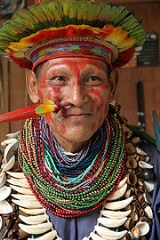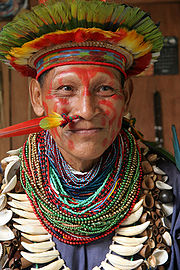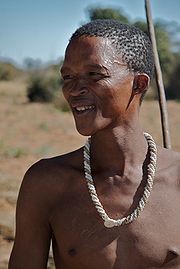
Indigenous and Tribal Populations Convention, 1957
Encyclopedia

International Labour Organization
The International Labour Organization is a specialized agency of the United Nations that deals with labour issues pertaining to international labour standards. Its headquarters are in Geneva, Switzerland. Its secretariat — the people who are employed by it throughout the world — is known as the...
Convention within the United Nations
United Nations
The United Nations is an international organization whose stated aims are facilitating cooperation in international law, international security, economic development, social progress, human rights, and achievement of world peace...
that was established in 1957. Its primary focus is to recognize and protect the cultural, religious, civil and social rights of indigenous and tribal populations within an independent country, and to provide a standard framework for addressing the economic issues that many of these groups face.
Today this Convention, C107, is considered outdated in the protection of indigenous rights
Indigenous rights
Indigenous rights are those rights that exist in recognition of the specific condition of the indigenous peoples. This includes not only the most basic human rights of physical survival and integrity, but also the preservation of their land, language, religion and other elements of cultural...
by the ILO organization. In 1989, the Indigenous and Tribal Peoples Convention, 1989
Indigenous and Tribal Peoples Convention, 1989
Indigenous and Tribal Peoples Convention, 1989 is an International Labour Organization Convention, also known as ILO-convention 169, or C169. It is the major binding international convention concerning indigenous peoples, and a forerunner of the Declaration on the Rights of Indigenous Peoples.It...
(C169) was written with the purpose of revising it. The new convention has been ratified by twenty countries, including some that denounced the 1957 convention. In the body of the more recent convention, we read, "[...] Considering that the developments which have taken place in international law since 1957, as well as developments in the situation of indigenous and tribal peoples in all regions of the world, have made it appropriate to adopt new international standards on the subject with a view to removing the assimilationist orientation of the earlier standards [...]".
Preamble

Article 1
The convention applies to members of a tribal population whose social and economic conditions are at a less advanced stage than other sections of the nation state and have their own customs and traditions. These tribal populations are people who are regarded as indigenousIndigenous peoples
Indigenous peoples are ethnic groups that are defined as indigenous according to one of the various definitions of the term, there is no universally accepted definition but most of which carry connotations of being the "original inhabitants" of a territory....
as they are the descendants of the original inhabitants of the region "...at the time of conquest, or colonization..." and who live more in common with their historical traditions and tribal institutions, than with the institutions of the nation state to which they belong. "Self-identification as indigenous ..." is the criteria to which this convention would apply.
Article 2
The convention requires that the nation state work with indigenous groups to create a legal framework for protecting the legal rights of the indigenous groups. These actions include ensuring that the indigenous individuals have the same rights as the non-indigenous, and to recognize and help preserve the traditions and cultural identity of the indigenous groups. Further actions include helping to remove economic gaps between the indigenous and other members of the nation state.Article 3
The convention maintains that indigenous and tribal peoples shall enjoy human rights and freedoms without discrimination, including gender discrimination.Article 4
The nation state will adopt protections for the "...safeguarding the persons, institutions, property, labour, cultures and environment of the peoples concerned." These measures are not to be in conflict with the wishes of the people concerned, and such safeguards will not be at the expense of the general rights of citizenship of the indigenous peoples.Articles 5-10
These articles support articles 1-4, giving methods for carrying out the general policy of the convention.Article 11
The indigenous and tribal populations shall have right of ownership over lands that they populations have traditionally occupied.Article 12
1. The indigenous and tribal populations shall not be removed without their free consent from their historical territories except regarding national laws, national security issues, national economic development, or for the health of the indigenous populations.2. If removal of these populations is absolutely necessary, they shall be given lands of equal quality to the lands previously occupied by them, suitable to provide for their present needs and future development.
3. Persons thus removed shall be fully compensated for any resulting loss or injury.
Article 13
1. Traditional customs of the transfer of land ownership rights shall be respected by the nation state "...within the framework of national laws and regulations... and do not hinder their economic and social development."2. "Arrangements shall be made to prevent persons who are not members of the populations concerned from taking advantage of these customs or of lack of understanding of the laws on the part of the members of these populations to secure the ownership or use of the lands belonging to such members".
Article 14
National state farm programs shall provide the necessary land needed for the indigiouns groups to provide "...the essentials of a normal existence", and "...promote the development of the lands which these populations already possess."Article 15
This clause deals with the rights of access to full and occupationally safe employment, without fear of discrimination, and under the same conditions as of the rest of the population, and provides for the right to join legal trade unions, with access to "medical and social assistance..." and adequate housing.Article 16-17
"Persons belonging to the populations concerned shall enjoy the same opportunities as other citizens in respect of vocational training facilities." If there are no vocational training programs in place for this population, the government will provide them. After a careful study of the economic environment and the "...stage of cultural development" and practical needs of the indigenous population, the government shall provide vocational training programs for them. These special training facilities shall be provided for "...only so long as the stage of cultural development of the populations concerned requires them," until they are replaced by the facilities provided for other citizens.Article 18
1. Handicrafts and rural industries shall be encouraged for economic development in a manner which will enable these populations to raise their standard of living, "...in a manner which preserves the cultural heritage of these populations and improves their artistic values and particular modes of cultural expression."Article 19-20
Government social security programs shall be extended to all wage earners and other persons belonging to these populations. Governments will provide adequate health services for the populations concerned, based on studies of their social, economic and cultural conditions.Article 21-22
Equal educational opportunities shall be available to the populations concerned at the same levels as other national citizens. Such education programs for shall be adapted "...to the stage these populations have reached in the process of social, economic and cultural integration into the national community," and such programs shall "...be preceded by ethnological surveys."Article 23
"Children belonging to the populations concerned shall be taught to read and write in their mother tongue or, where this is not practicable, in the language most commonly used by the group to which they belong." "Provision shall be made for a progressive transition from the mother tongue or the vernacular language to the national language or to one of the official languages of the country." "Appropriate measures shall, as far as possible, be taken to preserve the mother tongue or the vernacular language."Article 24-25
The national state will educate the children of the populations concerned to "... become integrated in the national community..." The national state will undertake educational measures for the national community "...eliminating prejudices that they may harbour in respect of these populations."Article 26
The nation state "...shall adopt measures, appropriate to the social and cultural characteristics of the populations concerned, to make known to them their rights and duties, especially in regard to labour and social welfare," and, if necessary, translate such information "...by means of written translations and through the use of media of mass communication in the languages of these populations."Article 27
This article contains support language that gives the national state the legal, administrative responsibility to create agencies to carry out the above programs.Article 28-31
These clauses contain support language describing the UN's understanding that each nation state's situation is going to be different, that this convention will not conflict with the benefits of other conventions, and would only be considered binding if accepted by the Director-General of the International Labour Office. This convention would come into effect after two nation states have ratified the agreement, and twelve months after the date of its registration.Article 32
The nation state may withdraw from the convention (described as "denounce" - see below under Ratifications) ten years after the date the convention comes into force, and must be filed within a one year period of that anniversary. If the state does not announce its denunciation from the convention within one year of the anniversary date, ten years must pass before another denunciation can be announced.Article 33-36
These articles contain support language that describes to whom and how the Director-General of the International Labour Office of the United Nations should register the country's admission of the convention.Article 37
"The English and French versions of the text of this Convention are equally authoritative."Modifications
This Convention was subsequently revised in 1989 by Convention C169 Indigenous and Tribal Peoples Convention, 1989Indigenous and Tribal Peoples Convention, 1989
Indigenous and Tribal Peoples Convention, 1989 is an International Labour Organization Convention, also known as ILO-convention 169, or C169. It is the major binding international convention concerning indigenous peoples, and a forerunner of the Declaration on the Rights of Indigenous Peoples.It...
.
Ratifications
| Country | Date | Notes |
|---|---|---|
 Angola Angola |
June 4, 1976 | ratified |
 Argentina Argentina |
January 18, 1960 | denounced on July 3, 2000 |
 Bangladesh Bangladesh |
June 22, 1972 | ratified |
 Belgium Belgium |
November 19, 1958 | ratified |
 Bolivia Bolivia |
January 12, 1965 | denounced on December 11, 1991 |
 Brazil Brazil |
June 18, 1965 | denounced on July 25, 2002 |
 Colombia Colombia |
March 4, 1969 | denounced on August 7, 1991 |
 Costa Rica Costa Rica |
May 4, 1959 | denounced on April 2, 1993 |
 Cuba Cuba |
June 2, 1958 | ratified |
 Dominican Republic Dominican Republic |
June 23, 1958 | ratified |
 Ecuador Ecuador |
October 3, 1969 | denounced on May 15, 1998 |
 Egypt Egypt |
January 14, 1959 | ratified |
 El Salvador El Salvador |
November 18, 1958 | ratified |
 Ghana Ghana |
December 15, 1958 | ratified |
 Guinea-Bissau Guinea-Bissau |
February 21, 1977 | ratified |
 Haiti Haiti |
March 4, 1958 | ratified |
 India India |
September 29, 1958 | ratified |
 Iraq Iraq |
July 16, 1986 | ratified |
 Malawi Malawi |
March 22, 1965 | ratified |
 Mexico Mexico |
June 1, 1959 | denounced on September 5, 1990 |
 Pakistan Pakistan |
February 15, 1960 | ratified |
 Panama Panama |
June 4, 1971 | ratified |
 Paraguay Paraguay |
February 20, 1969 | denounced on August 10, 1993 |
 Peru Peru |
December 6, 1960 | denounced on February 2, 1994 |
 Portugal Portugal |
November 22, 1960 | ratified |
| January 14, 1959 | ratified | |
 Tunisia Tunisia |
December 17, 1962 | ratified |
Reasons for denouncement of convention
All countries that declared that they "denounced" the convention did this as a result of the subsequent ratification of the Indigenous and Tribal Peoples Convention, 1989Indigenous and Tribal Peoples Convention, 1989
Indigenous and Tribal Peoples Convention, 1989 is an International Labour Organization Convention, also known as ILO-convention 169, or C169. It is the major binding international convention concerning indigenous peoples, and a forerunner of the Declaration on the Rights of Indigenous Peoples.It...
(No. 169). Those parties that remain "ratified" were not signatories to the later convention.
External links
- www.ilo.org/ Official ILO site

